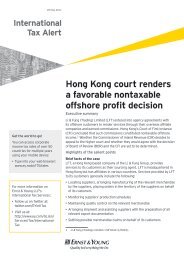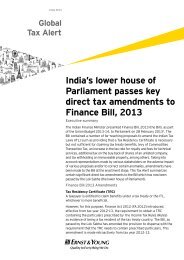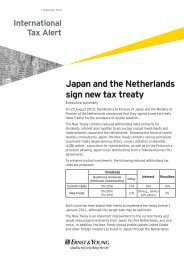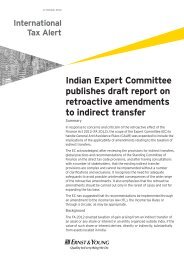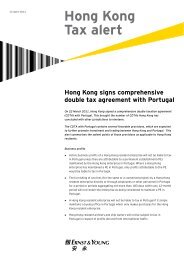Download - Ernst & Young T Magazine
Download - Ernst & Young T Magazine
Download - Ernst & Young T Magazine
You also want an ePaper? Increase the reach of your titles
YUMPU automatically turns print PDFs into web optimized ePapers that Google loves.
Management The reverse brain drain<br />
Human capital<br />
on the move<br />
The magnetic pull of skilled professionals and students from developing<br />
to developed markets is giving way to a more multipolar world, where countries<br />
increasingly compete for talent.<br />
Summary<br />
For the past century,<br />
the flow of talent has<br />
been largely from<br />
emerging to developed<br />
markets. But a more<br />
multipolar world is<br />
triggering new flows<br />
of skilled workers.<br />
This is sparking global<br />
competition for talent.<br />
• By Gerri Chanel<br />
People have been moving in search of better<br />
opportunities since the dawn of humanity.<br />
Back then, hunters migrated to stalk<br />
bigger herds. Today, it is intellectual capital on<br />
the move. Just a few years ago, talented<br />
engineers or scientists from such countries as<br />
India or China would make their way to countries<br />
such as the UK or the US. Today, those<br />
individuals are increasingly returning to their<br />
country of origin after obtaining education and<br />
experience – a phenomenon sometimes called<br />
“reverse brain drain.” Of course, one country’s<br />
brain drain is another’s gain, presenting<br />
challenges and opportunities for the countries<br />
– and companies – on both shores.<br />
China, India – and beyond<br />
Hai gui is the Mandarin term for sea turtle, a<br />
creature that is born on land, but grows up in the<br />
ocean before returning. It is also the informal<br />
term for the ever-growing number of Chinese<br />
graduates and professionals abroad who are<br />
increasingly returning home. China is not alone<br />
in this phenomenon: according to a 2011 study<br />
by recruitment consulting firm Kelly Services, an<br />
estimated 300,000 Indian professionals now<br />
working overseas are expected to return to India<br />
by 2015. Elsewhere, skilled expat workers from<br />
African countries such as Nigeria, Kenya, Ghana<br />
and Angola are also returning in notable<br />
numbers to their countries of origin, not<br />
least due to a slowdown in many richer<br />
economies.<br />
Joseph Pagop Noupoue, <strong>Ernst</strong> & <strong>Young</strong>’s<br />
Managing Partner for Cameroon, is one example.<br />
He recently relocated back to Africa after being<br />
educated and working in France for 23 years,<br />
and is far from alone. “We are receiving<br />
applications from so many young and talented<br />
Africans who are ready to make the trip back and<br />
bring their contribution to the development of<br />
the continent,” he says.<br />
Another notable trend is the movement<br />
of skilled workers within Europe due to varying<br />
economic conditions, says Michael Liley of<br />
<strong>Ernst</strong> & <strong>Young</strong>’s Human Capital practice<br />
in London and former Global HR Director of<br />
<strong>Ernst</strong> & <strong>Young</strong>. As a result, Spain, Italy and<br />
Greece now host a generation of highly-educated<br />
people in their mid-20s to mid-30s who cannot<br />
find good work. “So EU countries that are doing<br />
better economically, like Germany, have had<br />
quite a significant intake of qualified talent from<br />
those other countries,” he says.<br />
These trends are quite different to the<br />
established ones, which are characterized by the<br />
movement of talented workers from less<br />
developed to more developed countries. But a<br />
striking reversal may be looming, with various<br />
talent consultancies arguing that within several<br />
decades, many vacancies for senior roles in<br />
countries such as India will be filled not only by<br />
returning Indians, but also by Americans and<br />
Europeans seeking better prospects.<br />
Push and pull<br />
“The labor market is a major driver of talent<br />
migration,” says David Rooney, Executive<br />
Director of Global Mobility in <strong>Ernst</strong> & <strong>Young</strong>’s<br />
Human Capital practice, but he notes that it is<br />
only one of many factors, often categorized as<br />
either “push” or “pull.” Push factors might<br />
include lack of career or salary growth, or<br />
immigration policies that discourage permanent<br />
residence after training. “Pull factors,” he says,<br />
“may include higher wages or opportunity for<br />
career advancement, but there are others.<br />
Cultural affinity and family ties can also pull<br />
people back home, as well as pride around<br />
supporting growth in the home country, and<br />
sometimes simply quality of life.”<br />
According to a 2011 study sponsored by the<br />
Kaufmann Foundation in the US, which<br />
interviewed Indian and Chinese professionals<br />
who had been educated in America about their<br />
reasons for returning home, the top three<br />
34 T <strong>Magazine</strong> Issue 07 <strong>Ernst</strong> & <strong>Young</strong>



